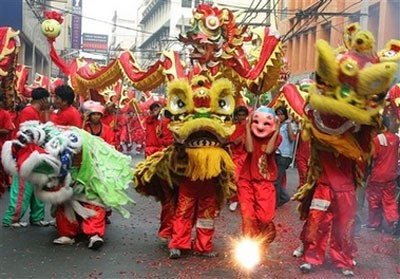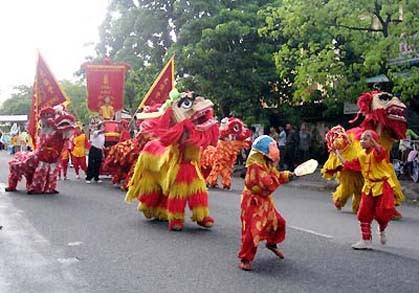Hello and welcome to VOV’s Letter Box, our weekly feature dedicated to listeners throughout the world. We are Mai Phuong and Ngoc Huyen.
A: First on our show today, we’d like to thank you all for your regular feedback to our broadcasts. As shortwave broadcasting is fading out amidst the explosion of digital media, your feedback has become a source of encouragement for us to continue broadcasting on shortwave.
B: This week, we received a number of emails from Dewan Rafiqul Islam of Bangladesh, who said he has been listening to VOV for 26 years. In an email on January 28, he wrote: “I find VOV more objective and informative. I made it my number one choice for learning the latest news, events and features around the world. I’m interested in your culture, history, and music. I listen to VOV as it is one of the most important radio stations to broadcast on shortwave which is entertaining, informative and also a min opener. It’s amazing there is so much to learn about Vietnam. I hope you stay on shortwave for many years to come”.
A: Thank you, Dewan, for your comments. We’ll send you QSL cards to verify your reception reports on January 25 and 27.
B: Next is a letter from Richard King of England. He wrote: “Despite all the predictions, I am pleased to see that shortwave broadcasting is still alive and well. I thought I would drop you a short letter to thank you for your shortwave broadcasts during 2014. Don’t believe all the hype that surrounds modern media such as internet and satellite broadcasting- not everybody wants to use those methods, there is still an active shortwave audience. Make sure that you tell your paymasters that there are still people like me listening to your broadcasts. Keep broadcasting programs about your ideals, culture, history and country- it is fascinating to someone like myself who admires other cultures and political messages”.
A: Richard confirmed that he received our Season Greetings and that he planned a holiday to Vietnam in September. He also sent us a postcard of London and a reception report on our broadcast on December 28 on the frequency of 5955 khz with a SINPO of all 4s.
B: Thank you, Richard. We highly appreciate your letter and especially your affection for VOV. We hope to see you soon in Hanoi.
A: This week, we received a letter from Grant Skinner of the UK, who has returned to VOV after a long break. Grant wrote: “I very much appreciate learning about new cultures and traveling the world through radio. I find the Voice of Vietnam to be one of the most interesting sources of information available and I appreciate news and viewpoints from outside my country”.
B: Using a Grundig YB 400 with extendable rod, Grant listened to our broadcast on January 16 on the frequency of 5955 Khz and rated SINPO at all 5s. Grant, thank you for tuning in to VOV. We’ll send you a QSL card to confirm your reception report soon.
A: From India, Kanchan KR Chatterjee of the Natun Radio Listeners’ Club sent us an email with best wishes for the New Year 2015. He wrote: “It has been a wonderful experience of the Voice of Vietnam in 2014. We hope that the same high quality of programs and friendly interactions with you will continue in the New Year. Our radio club members love the Voice of Vietnam and we are happy to receive VOV’s beautiful calendar”.
B: Last year, we received a lot of feedback from Radio Listeners Clubs and DX clubs from India, Bangladesh, the US and the UK. We hope to continue receiving feedback from you all.
A: SB Sharma of India reported listening to VOV’s program on January 27 and said he liked the story about lion dance group. He said he wanted to know more about lion dance in Vietnam.
B: In Vietnam, there are two versions of lion dance. In the north, it is called lion dance and is performed at the Mid Autumn Festival, which falls on the 15th day of the 8th lunar month. In the south, it is called unicorn dance and is often performed during the Tet holidays.
A: The unicorn, like the dragon, is a mythological animal and tradition has it that wherever a unicorn appears, people will have peace, happiness and prosperity.
B: The unicorn brings to mind the English griffin; it is represented with the body of an antelope, the feet of a horse, and the tail of a buffalo; and on the head of the male unicorn, there is a single horn, the extremity of which is covered with an excrescence of flesh. The unicorn is considered the symbol of intelligence and goodness, and appears only on very special occasions.
A: Today unicorn or lion dance is a joyful entertainment at the Tet festival in Vietnam. The unicorn is the symbol of power and prosperity. Well-to-do families use to set prize money and invite the Unicorn Dance team to come and dance in front of their house for entertainment and also as the first caller to their house on New Year's Day.
 |
B: The techniques of lion and unicorn dances are similar, although the traditional procession varies a little between the two regions. The northern lion comes out at dusk and is accompanied by a group of youngsters carrying different paper lanterns. The lanterns take the shape of various animals such rabbits, dragons or fish or they may look like multi-pointed stars.
A: In the south, unicorn dances take place during the day or evening. Brightly colored square flags replace the lanterns in the procession of the unicorn dance. Leading this procession are the flag carriers. The flags are usually donated by merchants whose shops will be visited by the lion dance troupe. The Vietnamese believe that the unicorn is a symbol of wealth and prosperity and therefore they are generous in their donations to the unicorn dance teams. After the flags comes the unicorn. Big processions may have more than one.
B: Then there is a mythical creature called the "Dia" known by a moonlike facemask and a man carrying a pole which is topped with a round ball representing a piece of jade. At the tail end come the drums and cymbals, usually mounted on a cart which provide the loud and rhythmical accompaniment to the dance.
A: Several men take turns handling the unicorn. They wear tight uniforms of various colors which are often identified with the particular locality where the dance takes place. Each unicorn group covers a well-defined area and they do not trespass on each other's territory. In Ho Chi Minh city, the unicorn procession begins early in the morning on the first day of Tet. It systematically visits every home and shop in its area. As soon as it appears in front of a house, the place swarms with children and onlookers. First, the drums and cymbals sound a salute to the occupants of the house. The unicorn stoops down, bowing its head several times before the entrance door, then steps back to repeat the same gesture five or six times before beginning the dance.
 |
B: The home owner or shopkeeper then presents his donations, but to make the event more challenging and exciting, people hang their gifts from a second story balcony or window, or from a pole like bait on a fishing rod. To cope with this challenge, the unicorn dancers are strong and agile people and must be good climbers. To reach the target, the unicorn must be elevated through a human pyramid to the height of the suspended gift. Sometimes they reach it using a ladder. All the while, the unicorn dances to the rhythm of the throbbing drums while the excited crowd below noisily shouts encouragement. The best part comes when the prize (usually money) is grabbed by the unicorn's mouth and then slowly the group moves on to the next house for another donation.
A: If you come to Vietnam during Tet or mid-Autumn festival, don’t miss the lion or unicorn dance. In today’s program, we’d like to acknowledge emails and letters from Ratan Kumar Paul of India, Jeffrey Lee of the US, Adrejs Kuznecovs of Latvia, Denis Ironman of the UK, and Mizanur Raman of Bangladesh. We’ll send you QSL cards and the souvenirs you requested soon.
A: We welcome your feedback at: English section, Overseas Service, Radio Voice of Vietnam, 45 Ba Trieu Street, Hanoi, Vietnam. Or you can email us at: englishsection@vov.org.vn. You’re invited to visit us online at www.vovworld.vn, where you can hear both live and recorded programs. Good bye until next time.